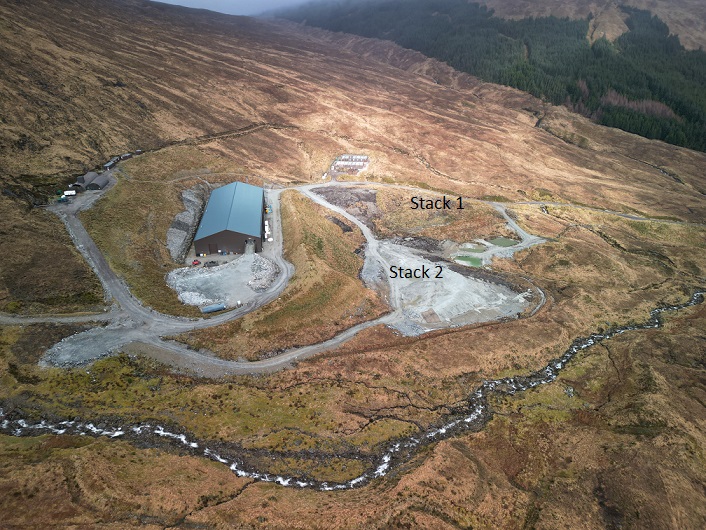
On 24th November Pitcher Partners, a company based in Western Australia, were appointed administrators for Scotgold Resources and its subsidiaries which operate in Scotland, SGZ Cononish, which operates the Cononish goldmine and its exploratory company SGZ Grampian. Two weeks ago a reader pointed me to information about two meetings Pitcher Partners held with creditors of the mine in December (see here). The administrator would not normally call such meetings if there was any chance of selling a business. Another creditors meeting scheduled for 28th February will consider “the early destruction of books and records”. Despite the lack of any announcement on the Alternative Investment Market or other media coverage it very much looks like Scotgold and its subsidiaries are in the process of being liquidated.
That creates new risks and given that an FOI response from the Scottish Environmental Protection Agency (SEPA) showed a significant pollution incident had taken place after the mine had ceased to operate (see here). I decided to go and have a look at the state of the mine with a young film maker. (You can watch his short video, which was viewed 100,000 times in the first week and has 230 comments here). All the photos are from that visit, a dry day after a dryish spell. This post considers the financial and environmental implications of the mine closure over the short, medium and long-term and the Loch Lomond and Trossachs National Park Authority (LLTNPA)’s response to date.
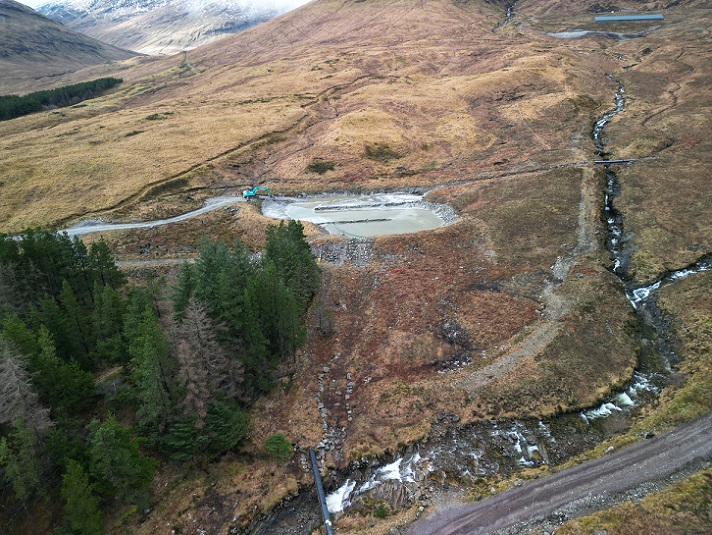
Who is currently managing the Cononish goldmine site?
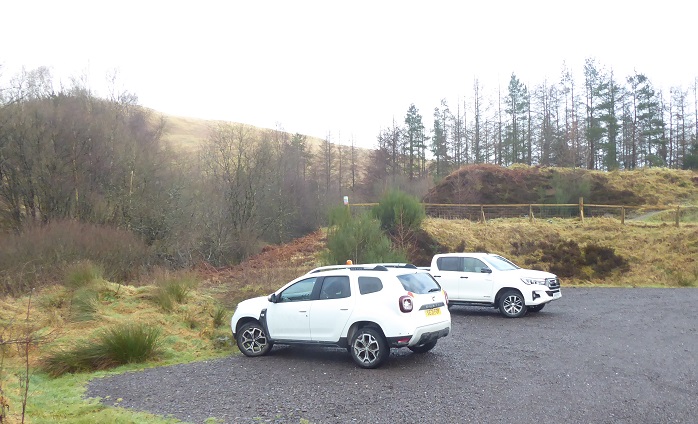
After Scotgold laid off most of its workforce at the end of September, the LLTNPA’s Director of Place, Stuart Mearns, reported to the Planning Committee Meeting on 30th October (see here) that:
“A core team of staff has been kept on site to ensure that environmental monitoring continues and a care and maintenance programme has been put in place. At the time of writing, officers are content with the arrangements that have been put in place in the circumstances”
It seemed likely that that core team would have been laid off as soon as the administrators decided they could not sell the mine, due to their legal duty to make maximum use of Scotgold’s remaining assets for distribution to creditors. That suspicion was re-inforced when the local police issued a warning after members of the public had entered the mine (see here).
We were slightly surprised therefore to find two vehicles in the car park at Dalrigh reserved for mine staff but I have subsequently ascertained these were unlikely to be mine vehicles. While walking round the perimeter of the site we saw only one vehicle and one person who came out to look at us, most probably having been alerted by security cameras, before they left the site. We saw no-one else, quite a change from the core team who were there in September.
The other significant change since my last visit in October was that the noise of the generators which had powered the pumps in the mine had gone. That means the mine will be filling up with water, another sign that it is finished as a working operation, but at the same time creates new pollution risks.
Short-term risks
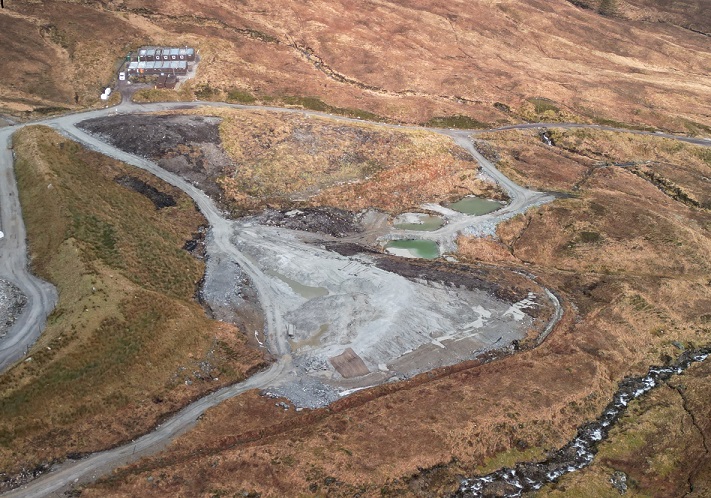
The LLTNPA has a restoration bond in place designed to pay for restoring of the mine site should it be shut down or abandoned. However, it has no arrangements in place to cover care and maintenance of the site in the period between the mine ceasing operations and a final decision to shut it down. That was not a problem so long as Scotgold or any administrator was trying to find new investors as the success of any sale was dependant on the mine being kept in a reasonable state. But once the mine was in administration and the administrators had decided to liquidate the business, there was no reason for them to maintain a core team to abide by planning conditions. That would only reduce the remaining assets which they have to distribute to creditors, who are likely to include local businesses.
The most that the LLTNPA could do to address this situation would be to shut the mine down, which is what the administrators are intending to do anyway.
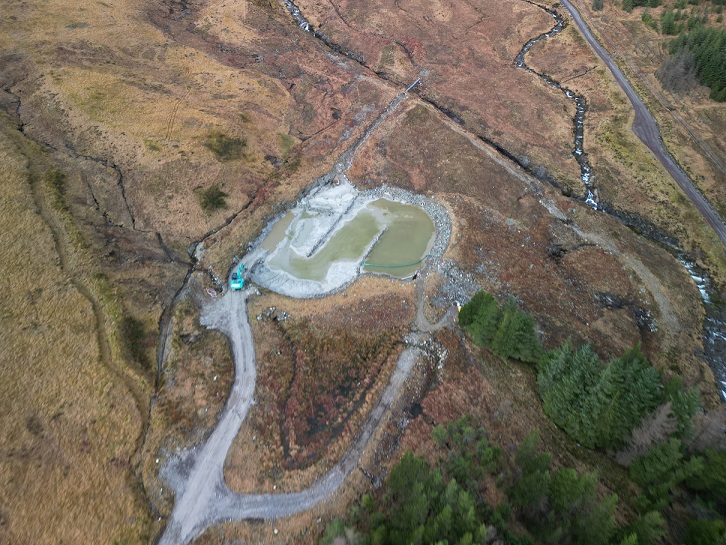
It appears that some arrangements may still be in place to care and maintain the mine site. In the photo above the presence of the digger and the green boom, designed to protect the outflow from the pond and in the right place, suggests some maintenance has been taking place. The pond, however, is not being emptied of sediment as it should be and there was little other machinery visible on site (another contrast to my visit in October). It is possible therefore that maintenance is being provided by contractors on a needs be basis rather than staff permanently based on the site who can see what is going on. If so, it is not clear who is paying for this.
If it has fallen to the LLTNPA to pay, this could explain why the “care and maintenance” team now appears so reduced in size. This raises other questions. Who for example is paying for the mine monitoring visits since the business entered administration? Are these visits now taking place and if so how have they been adjusted to reflect the greatly reduced staff presence on site?
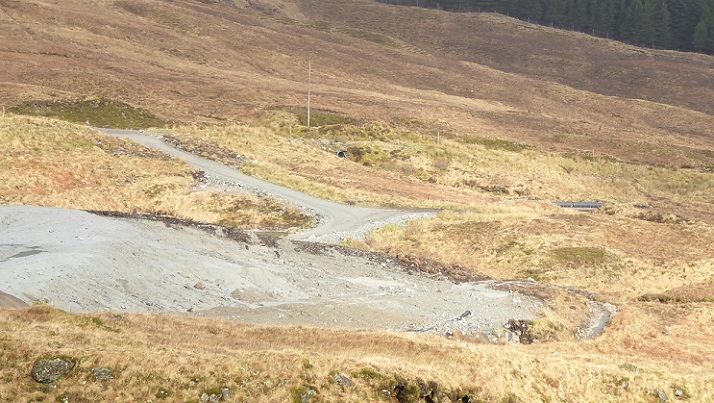
The main short-term risk at present is the “new” tailings stack that was started last year and the significant amounts of silt that are visible across the site. On a dry day and in a dry period, such as when we visited, this is not a problem. The issue is when the site is very wet and it then rains heavily.
The Mine Monitoring reports published on the LLTNPA’s planning portal record a history of sediment laden discharges into the River Cononish after heavy rainfall, a breach of planning conditions. For example, the most recent report dated 23rd August 2023 and published last week reports:
“On the 20.09.23 [note the date!!] SGZ reported to SEPA & NPA, in accordance with their Incident Response Plan that the licenced discharge exceeded 100mg/l of suspended solids into the Cononish over the preceding 24 hours. The period saw 100mm of rain in 36 hours”
Having shown little concern about addressing these unlicensed discharges when Scotgold was operating the mine, it is unlikely the LLTNPA will do so now. The “final work” on the “commissioning” of the lower settlement pond, lining it with concrete to stop it leaking, had been delayed for months and in August was still marked amber under the traffic light system used in these reports. That is despite the LLTNPA’s policy that amber actions should turn to red if not completed between one report and the next. Because of the amount of silt on site, fixing the pond will still probably be required before the pond can be decommissioned and if so it will be the LLTNPA – or rather the public purse – which will pick up the bill.

As far as the risk of a major sediment discharge incident is concerned, the LLTNPA have probably been saved by the fact that the mine produced so little gold in its last five months of operation. The amount of rock waste that has been crushed and turned into tailings is relatively very small.
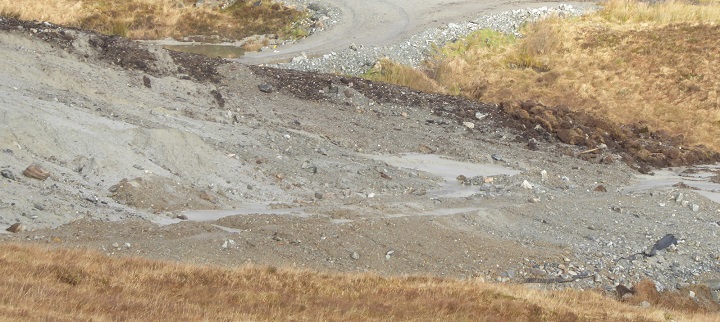
While Stack 2 is clearly eroding away at present, in breach of planning conditions and basic good environmental practice, it may be that the quantity of tailings is insufficient to cause a landslip or for the amount of sediment being washed into the River Cononish Special Area of Conservation to have catastrophic consequences for wildlife. It is possible that the LLTNPA is banking on that and the amount of sediment being discharged into the river system will remain within bounds acceptable to SEPA.
That, however, leaves the question about whether the sediment that is being discharged into the river system is toxic or not. The August Mine Monitoring reports records:
“Groundwater sampling was taken on 31st August 2023. Exceedances in Iron occurred at one location DS2D, exceedance in Cadmium at DS1D. All the other analyte were within the required thresholds”
There is, therefore, metal pollution on the site. The question is whether this has become worse since the mine was abandoned and whether the location and frequency of the sampling is appropriate to pick up the most likely sources of pollution currently. Whether the LLTNPA and SEPA have addressed this issue is not known.
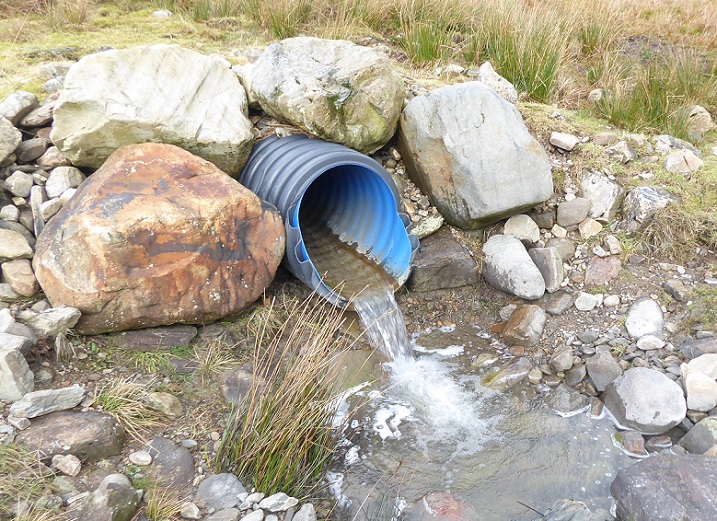
There was not much water flowing out of the pipe from the lower settlement pond and while not laden with sediment it was not as clear the river above. One would have been a fool to drink it.
Medium terms risks
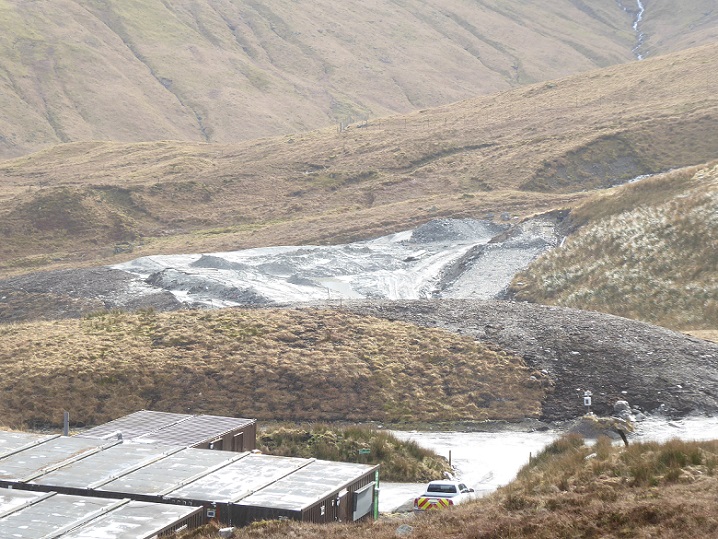
In 2023 the LLTNPA reviewed the amount of the bond designed to cover the costs of restoring the mine should it be closed or abandoned. It was increased by c£85k but a report to the October planning committee shows £45,848.24 of that was not paid by Scotgold. In addition the review of the Greater Cononish Management plan bond was never completed so it is likely that the LLTNPA is already at least £60k short of what it said is needed to restore the mine site.
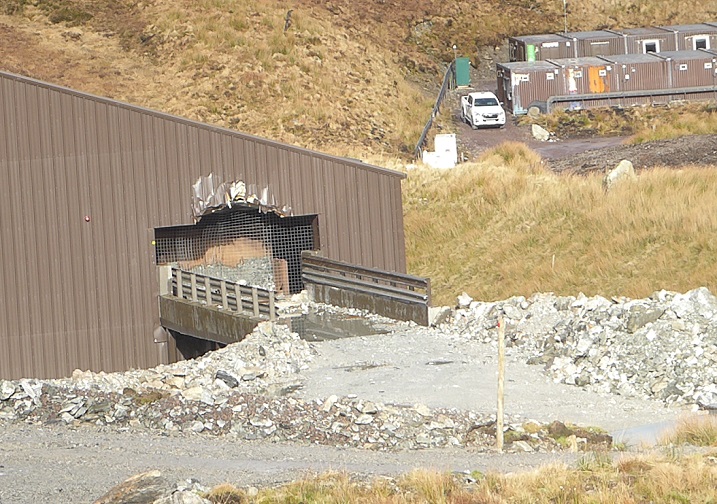
The Restoration bond and its review, however, were calculated on the assumption that the planning conditions that had been put in place had been observed. The state of Stack 2, which may well need to be re-designed, and the settlement ponds could well incur more costs. On top of that, however, there will be the costs of removing developments on site which were never granted planning permission, the state of other infrastructure on site (its re-sale,scrap value) and incomplete restoration work.
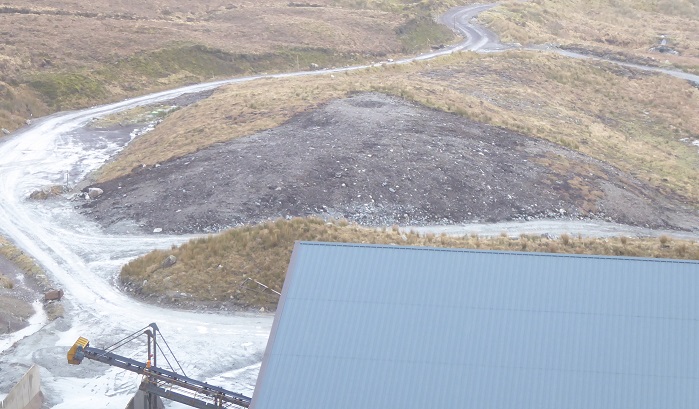
The August monitoring report records that the bare area of Stack 1 had been returfed and according to SGZ Cononish re-seeded. There is not much sign of that now and meantime the bare peaty soil has been leaking carbon into the atmosphere and gradually eroding. Scotgold claimed they did not have enough turf to cover this stack, as per the planning conditions, so where is the LLTNPA going to get the turf to cover Stack 2?
The major risk now is that the LLTNPA, left with the responsibility of restoring the mine site and strapped for cash like most public authorities, will try to take short-cuts to make up for the financial shortfalls and not restore the mine site properly. The best way to prevent that is for Lorna Slater, the Minister responsible for National Parks, to insist on complete transparency about the state of the site and the cost of all the restoration work. Perhaps she could also suggest to King Charles, who benefited directly from the Crown Estate’s licenses to Scotgold (the Royal Family receive 20% of all the income they generate), that he might contribute to any shortfall in the restoration monies as a sign of his environmental credentials?
The long-term risks
The quantification of the cost of the work required to restore the site, which I obtained through an FOI request last year 5_Bond Quantification 2022, while quite extensive only deals with the above ground parts of the mine. It allocates c£5 to seal the mine and then totally disregards the areas below ground.
The evidence from England suggests this may be a very costly omission. The number of rivers affected by metal pollution from mines in England is significant and there is a programme in England to address this (see here). Last Autumn, around the time the Cononish mine ceased to operate, the UK government announced a £9m programme to treat metal pollution in North East England was almost complete (see here). Two and a half years ago Natural Resources Wales estimated the cost of the metal clear-up there would be £282m (see here). While the Cononish Restoration bonds includes an allowance to cover the site and rivers below being monitored for a number of years, the total for contingencies is £36,342.06.
If the mine starts leaking metal pollution in the medium term that is not nearly enough to deal with problem. When the LLTNPA did a U-turn and under political pressure decided to approve the goldmine it effectively abandoned the precautionary principle and the public may yet pay a massive price.
The LLTNPA’s response to the risks posed by the closure of the gold mine
On Monday there is a meeting of the LLTNPA’s planning committee. While I am delighted to see a draft objection to the Vale of Leven windfarm is on the agenda (see here), the Cononish goldmine isn’t. That is despite what was recorded in the minutes of the October meeting:
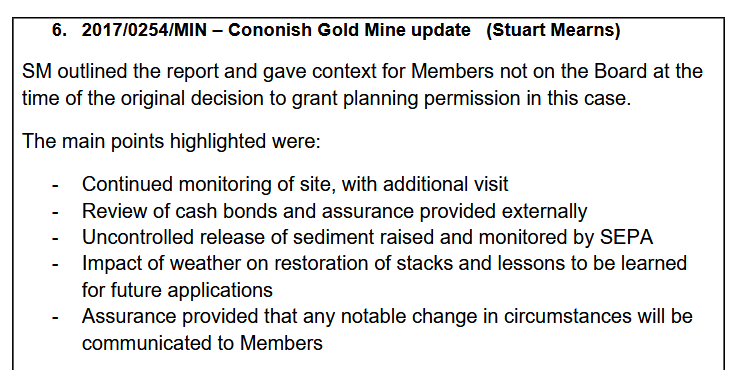
Given this the least one might have expected is that officers might have presented a report to the meeting setting out the changes in the care and maintenance arrangements, the state of the tailings stack, the implications of the creditors meetings (has the LLTNPA even registered as a creditor given it appears to be owed money by Scotgold?). A half-decent National Park Authority might also have invited Board Members to discuss some of the implications I have described in this post and what to do about them.
While it is now too late to deal with many of the issues, had the Board been asked to withdraw the planning consent for the mine now, it could have availed itself of the restoration bond and started to restore the site reducing the short-term risks being caused by the mine being left almost unattended.
I have lost count of the number of emails I have sent to Dr Heather Reid, the Convener of the LLTNPA, asking her to consider these issues and so far have never had the courtesy of a direct reply or acknowledgement. Cononish, you see, in Dr Reid’s view is an operational matter to be left for staff. I am tempted to say “God save the National Park” but failing that Lorna Slater should step in and insist the LLTNPA Board consider the issues and send in external advisers to help.
If the mine business is being liquidated who is going to own the site? Is it leased from an estate or is it in the process of becoming un-owned?
The mine is owned by Cononish Farm and was leased by them to the goldmine. Unless the land is fully restored it could now turn into a liability for them rather than an asset
Are the planning conditions tied up in a Section 60 agreement? If so, are the land owners signataries to the agreement? If so, there is potential that they may still hold some responsibility for site restoration.
Thank you for your in-depth survey and continuous work in relation to this venture. For such a development is there not a bond with the Scottish Government or licenceng authority for the project requiring that the land be restored to a reasonably original state?
There is a restoration bond which last year the LLTNPA decided was insufficient. They increased the amount required but the public evidence available shows only half was paid. If the full amount had been paid it is unclear why the LLTNPA would keep that secret. The bond however was calculated on the basis that all planning conditions were observed, ie the site was in reasonable state. The Monitoring reports show that is not the case and therefore the bond is likely to be insufficient. These are the issues that should have been and still need to discussed openly by the LLTNPA Board who have simply acceded to staff requests to treat what is happening at the mine as an operational matter